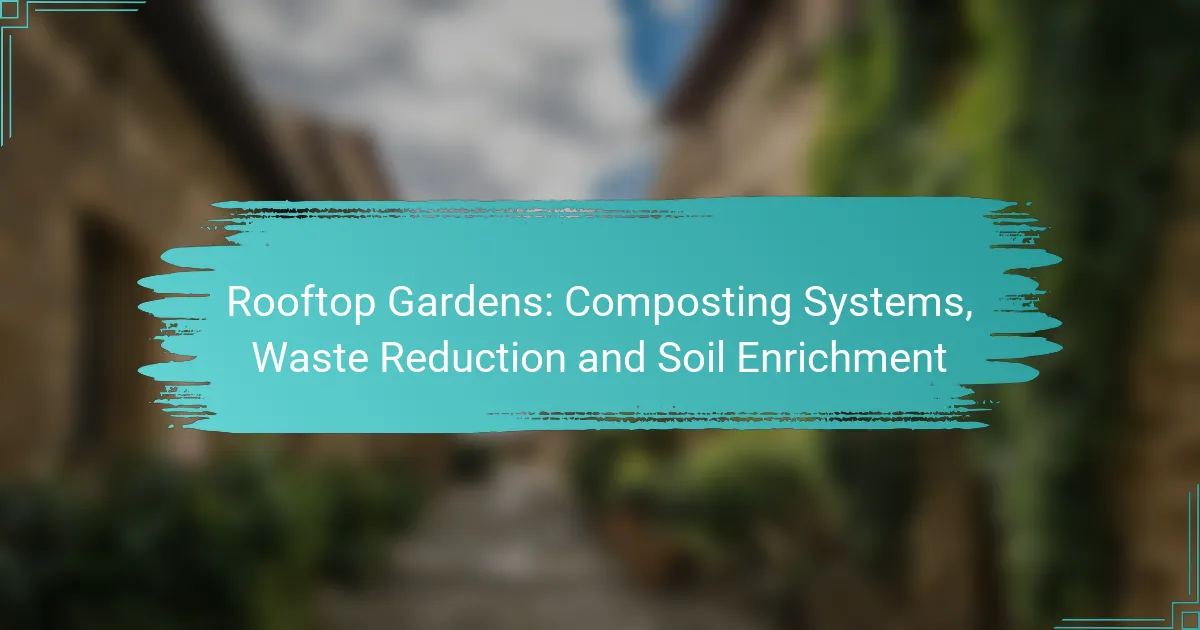Rooftop gardens play a vital role in urban sustainability by transforming unused spaces into green havens that improve air quality and promote biodiversity. Implementing effective composting systems within these gardens not only enriches the soil but also reduces waste, making it easier to maintain a healthy ecosystem in limited urban environments.
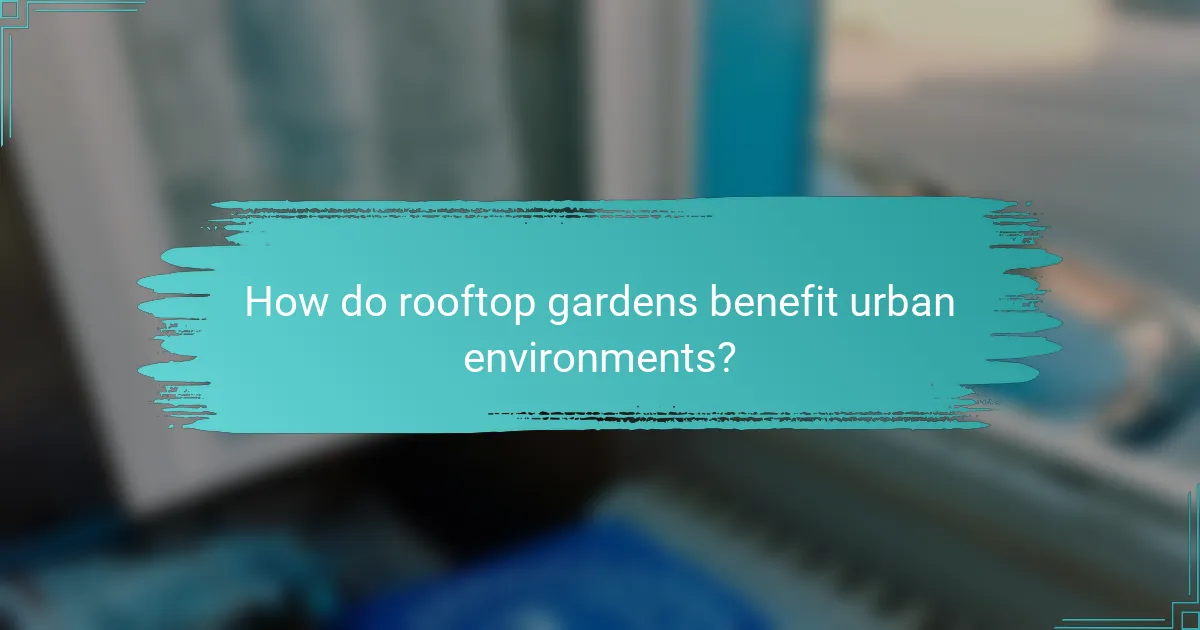
How do rooftop gardens benefit urban environments?
Rooftop gardens significantly enhance urban environments by improving air quality, reducing the urban heat island effect, and promoting biodiversity. These gardens utilize otherwise unused space, transforming rooftops into green areas that contribute to healthier and more sustainable cities.
Improved air quality
Rooftop gardens play a crucial role in improving air quality by filtering pollutants and absorbing carbon dioxide. Plants in these gardens can capture particulate matter and other harmful substances, leading to cleaner air in densely populated areas.
To maximize air quality benefits, consider incorporating a variety of plants, including trees, shrubs, and flowering species. This diversity can enhance the garden’s ability to filter air and provide additional aesthetic value.
Reduced urban heat island effect
Rooftop gardens help mitigate the urban heat island effect by providing insulation and reducing the amount of heat absorbed by buildings. Green roofs can lower surface temperatures by several degrees, which in turn can decrease energy consumption for cooling.
When designing a rooftop garden, aim for a thick layer of soil and a diverse plant selection to maximize cooling effects. This can lead to lower energy bills and a more comfortable urban environment during hot months.
Enhanced biodiversity
Rooftop gardens contribute to enhanced biodiversity by creating habitats for various species, including birds, insects, and other wildlife. These green spaces can serve as important refuges in urban areas where natural habitats are scarce.
To attract more wildlife, incorporate native plants that provide food and shelter. This not only supports local ecosystems but also promotes pollination and contributes to the overall health of urban flora and fauna.
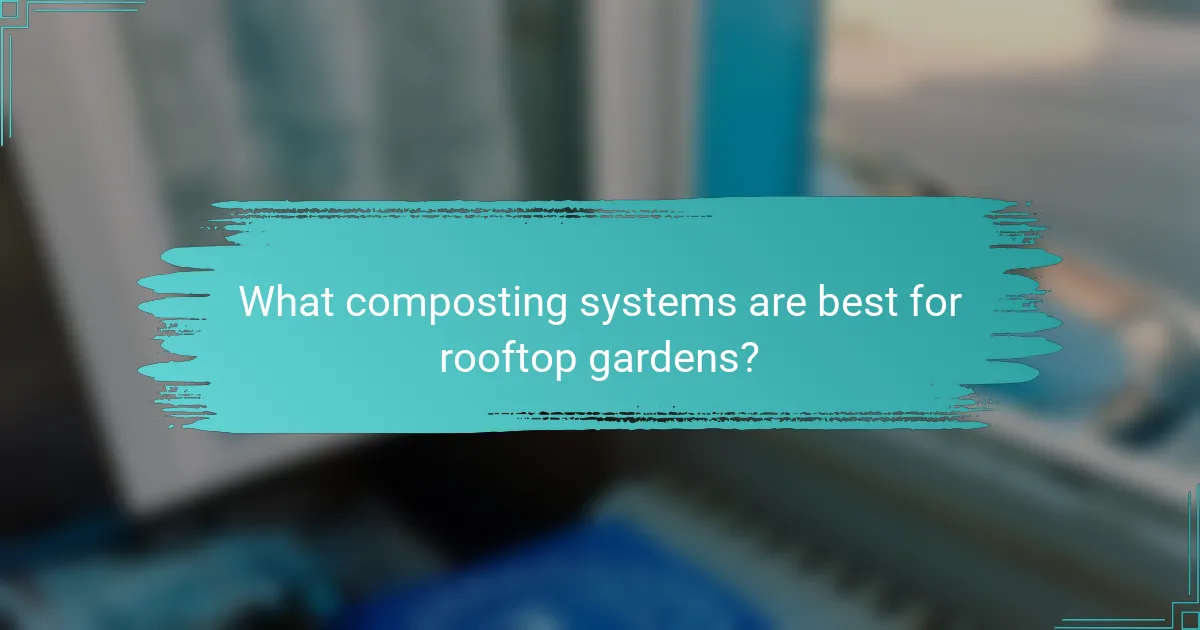
What composting systems are best for rooftop gardens?
The best composting systems for rooftop gardens are those that maximize space efficiency and minimize odor while enriching the soil. Options like worm composting, hot composting, and compost tumblers each offer unique benefits and considerations suited for limited urban environments.
Worm composting (vermicomposting)
Worm composting, or vermicomposting, utilizes specific worm species to break down organic waste into nutrient-rich compost. This method is particularly effective in small spaces, making it ideal for rooftop gardens where space is limited.
To start, you need a worm bin, bedding material like shredded newspaper, and red wigglers or other composting worms. Maintain moisture and avoid overfeeding to keep the worms healthy. Regularly harvest the compost every few months to enrich your garden soil.
Hot composting systems
Hot composting systems rely on a balance of green (nitrogen-rich) and brown (carbon-rich) materials to create heat, which accelerates decomposition. This method can produce compost in a matter of weeks, making it efficient for rooftop gardeners looking for quick results.
To implement hot composting, create a pile or use a bin that allows for aeration. Ensure the pile reaches a temperature of at least 55°C (130°F) by regularly turning it and monitoring moisture levels. Be cautious of odors; if they arise, adjust the carbon-to-nitrogen ratio.
Compost tumblers
Compost tumblers are enclosed bins that allow for easy mixing of compost materials, promoting faster decomposition. They are particularly useful for rooftop gardens due to their compact design and ability to minimize pests and odors.
To use a compost tumbler, fill it with a mix of green and brown materials, then rotate it regularly to aerate the compost. Most tumblers can produce finished compost in about 4 to 6 weeks, making them a practical choice for urban gardeners. Ensure you monitor moisture and avoid overloading the tumbler to maintain efficiency.
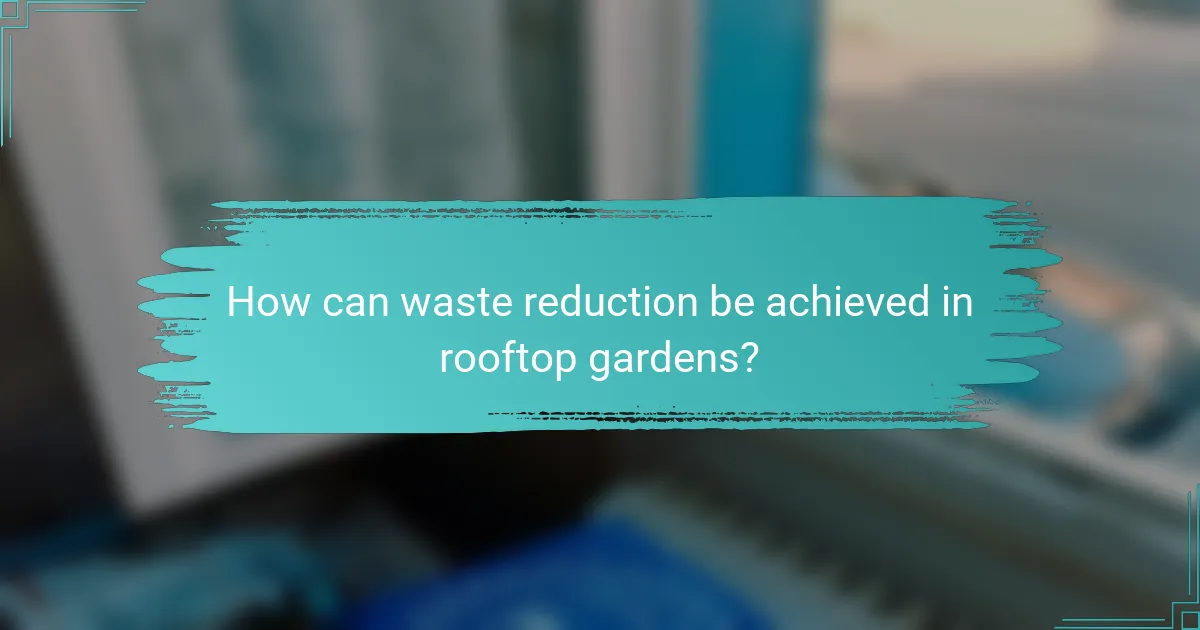
How can waste reduction be achieved in rooftop gardens?
Waste reduction in rooftop gardens can be effectively achieved through strategies like composting, recycling, and utilizing organic materials. These practices not only minimize waste but also enhance soil quality and promote sustainable gardening.
Utilizing kitchen scraps
Kitchen scraps are an excellent resource for reducing waste in rooftop gardens. Items such as vegetable peels, coffee grounds, and eggshells can be composted to create nutrient-rich soil amendments. This practice not only diverts waste from landfills but also enriches the garden’s soil.
To effectively use kitchen scraps, consider setting up a small compost bin or a worm composting system. Aim to maintain a balance of green materials (like fruit and vegetable scraps) and brown materials (such as dried leaves or cardboard) to optimize decomposition.
Implementing recycling practices
Recycling practices can significantly contribute to waste reduction in rooftop gardens. Items like plastic containers, glass jars, and cardboard can be repurposed for planting or storage. For instance, old containers can serve as planters, while cardboard can be used as mulch to suppress weeds.
Establish a recycling station in your garden area to sort materials easily. Ensure that you follow local recycling guidelines to maximize the effectiveness of your efforts, as regulations may vary by region.
Partnering with local composting services
Partnering with local composting services can enhance waste reduction efforts in rooftop gardens. Many cities offer community composting programs that accept organic waste, providing gardeners with high-quality compost in return. This collaboration not only reduces personal waste but also supports local sustainability initiatives.
Research local composting services to find options that suit your needs. Some services may offer pick-up for a fee, while others have drop-off locations. Engaging with these services can also foster community connections and promote environmental awareness.

What are the key components of soil enrichment?
Soil enrichment involves enhancing soil quality to support plant growth through various methods. The key components include organic matter addition, microbial activity enhancement, and pH balance adjustment.
Organic matter addition
Adding organic matter is crucial for improving soil structure and fertility. This can be achieved through compost, mulch, or green manures, which provide essential nutrients and improve moisture retention.
When selecting organic materials, consider using local resources like yard waste or kitchen scraps. Aim for a balance of carbon-rich (browns) and nitrogen-rich (greens) materials to optimize decomposition and nutrient release.
Microbial activity enhancement
Enhancing microbial activity is vital for nutrient cycling and soil health. Healthy soil contains a diverse community of microorganisms that break down organic matter and make nutrients available to plants.
To boost microbial populations, incorporate compost and avoid chemical fertilizers that can harm beneficial organisms. Regularly aerating the soil and maintaining adequate moisture levels also support a thriving microbial ecosystem.
pH balance adjustment
Adjusting soil pH is essential for optimal nutrient availability. Most plants thrive in slightly acidic to neutral pH levels (around 6.0 to 7.0), while extreme pH levels can hinder nutrient uptake.
To test soil pH, use a simple kit available at garden centers. If adjustments are needed, add lime to raise pH or sulfur to lower it, following local guidelines for application rates to avoid overcorrection.
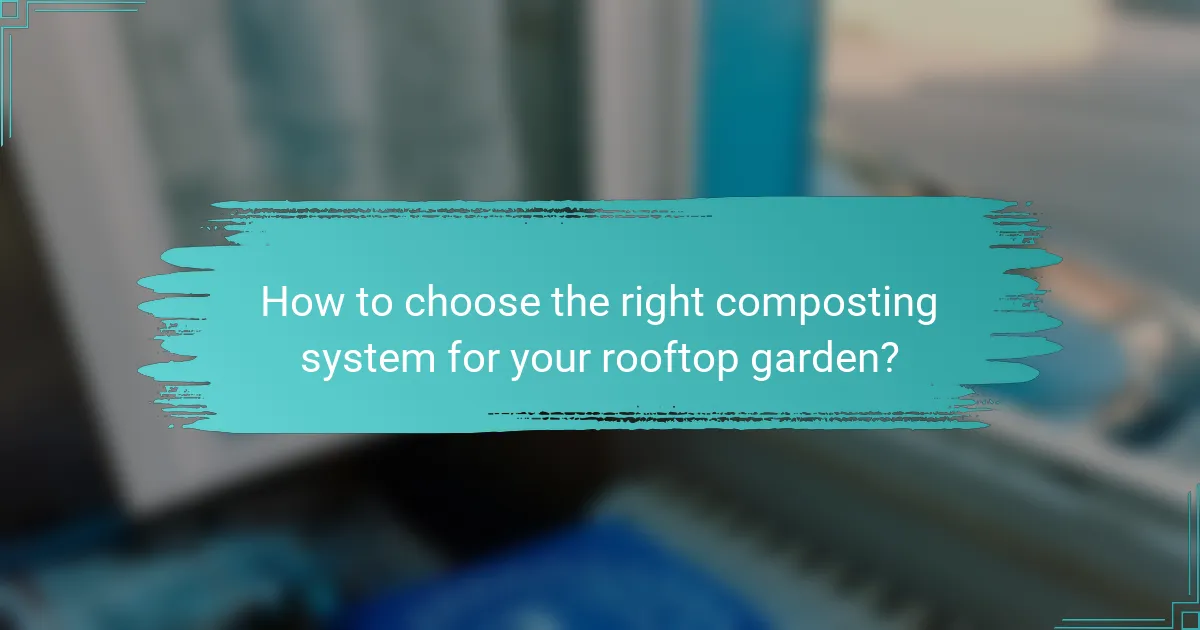
How to choose the right composting system for your rooftop garden?
Choosing the right composting system for your rooftop garden involves considering space, maintenance, and climate. A suitable system will optimize waste reduction and enrich your soil effectively.
Consider space limitations
Space is often a constraint in rooftop gardens, so it’s crucial to select a composting system that fits your available area. Options like worm bins or compact tumblers are ideal for smaller spaces, while larger compost bins may require more room.
Measure your rooftop area and assess how much space you can allocate for composting. Ensure that the system you choose allows for proper aeration and drainage, which are essential for effective composting.
Evaluate maintenance requirements
Different composting systems come with varying maintenance needs. For instance, worm bins require regular feeding and monitoring of moisture levels, while tumblers may need occasional turning but are generally easier to manage.
Consider how much time you can dedicate to composting. If you prefer a low-maintenance option, a passive compost bin that requires minimal intervention might be the best choice.
Assess local climate conditions
Your local climate significantly impacts composting efficiency. In warmer climates, composting processes may accelerate, while colder areas may slow them down. Choose a system that can adapt to your climate, such as insulated bins for colder regions.
Additionally, consider seasonal variations. For example, during heavy rainfall, ensure your composting system has adequate drainage to prevent waterlogging, which can hinder the composting process.
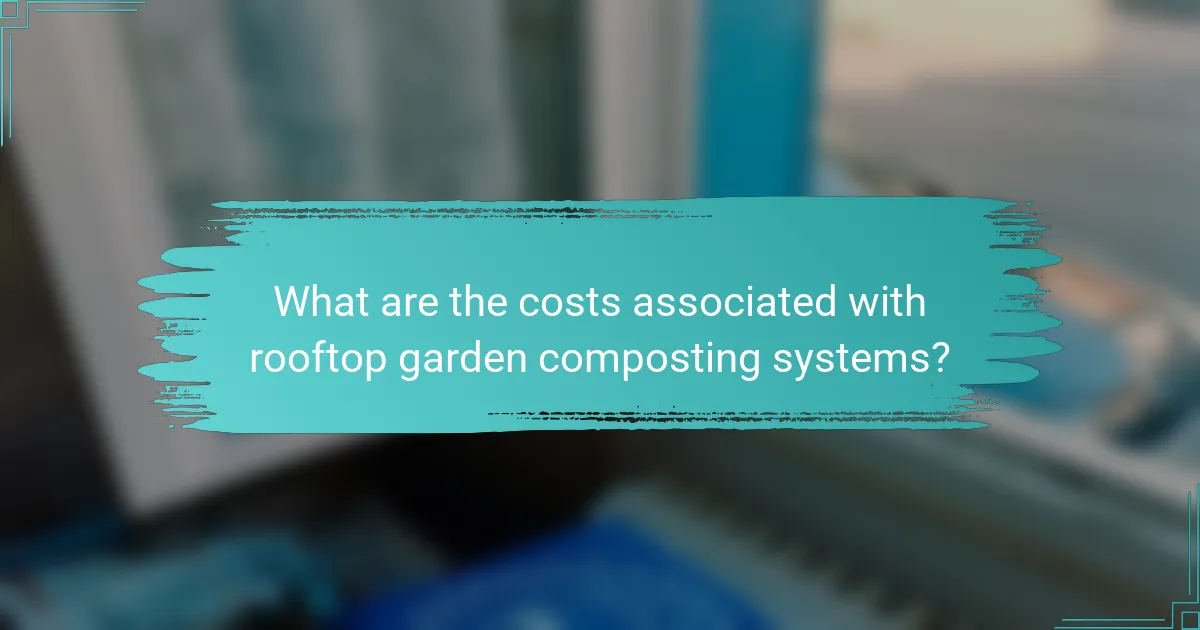
What are the costs associated with rooftop garden composting systems?
The costs associated with rooftop garden composting systems can vary widely based on factors like size, materials, and installation. Generally, initial investments can range from a few hundred to several thousand dollars, depending on the complexity of the system and the specific needs of the garden.
Initial setup costs
Initial setup costs for rooftop garden composting systems typically include purchasing compost bins, soil amendments, and any necessary tools. Basic compost bins can start around $50, while more advanced systems may exceed $500. Additionally, soil and organic matter can add another $100 to $300 to your budget.
Consider the size of your rooftop garden when estimating costs. A larger garden will require more composting materials and potentially more sophisticated systems, which can increase initial expenses. It’s advisable to plan for at least a few hundred dollars to ensure you have a functional and efficient composting setup.
Do not overlook potential labor costs if you plan to hire professionals for installation. Depending on your location, labor fees can add significantly to your initial investment, so consider DIY options if you have the skills and time to manage the setup yourself.
